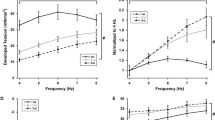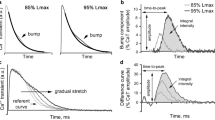Abstract
Myocardial calcium handling differs between species, mainly in the relative contribution between the sources for activator calcium. To investigate the role of the myofilaments and intracellular calcium decline in governing the relaxation phase of cardiac muscle, and to elucidate additional determinants of relaxation other than the sarcoplasmic reticulum (SR) at various frequencies within the in vivo range, the present study was performed by altering the calcium handling in rat and rabbit. Trabeculae, iontophoretically loaded with bis-fura-2 to monitor cytoplasmic calcium levels, were subjected to ryanodine and cyclopiazonic acid to inhibit SR function. Simultaneous force and [Ca2+]i measurements were obtained at 1–4 Hz in rabbit and at 4–8 Hz in rat before and after SR inhibition. Inhibition of the SR resulted in increased diastolic and peak calcium levels as well as decreased developed force in both species. Calcium transient amplitude decreased in rat, but increased in rabbit after SR inhibition. Time to peak tension, time from peak tension to 50% relaxation, time to peak calcium, and time from peak calcium to 50% calcium decline were all prolonged. Results suggest that L-type calcium channel current is responsible for increases in calcium with increasing frequency, and that the SR amplifies this effect in response to increased L-type current. The response of the myofilaments to alterations in calcium handling plays a critical role in the final determination of force, and may differ between species. These results imply the balance between force relaxation and calcium decline is significantly different in larger mammals, necessitating a critical re-evaluation of how myocardial relaxation is governed, specifically regarding frequency-dependent activation.






Similar content being viewed by others
Abbreviations
- Fdev :
-
Developed force
- TTP(tension) :
-
Time to peak tension
- RT50 :
-
Time from peak tension to 50% relaxation
- RT90 :
-
Time from peak tension to 90% relaxation
- TTP(calcium) :
-
Time to peak calcium
- CD50 :
-
Time from peak calcium to 50% calcium decline
References
Backx PH, Ter Keurs HE (1993) Fluorescent properties of rat cardiac trabeculae microinjected with fura-2 salt. Am J Physiol Heart Circ Physiol 264:H1098–H1110
Bassani JW, Bassani RA, Bers DM (1994) Relaxation in rabbit and rat cardiac cells: species-dependent differences in cellular mechanisms. J Physiol 476:279–293
Bassani RA, Altamirano J, Puglisi JL, Bers DM (2004) Action potential duration determines sarcoplasmic reticulum Ca2+ reloading in mammalian ventricular myocytes. J Physiol 559:593–609
Bers D (2001) Excitation–contraction coupling and cardiac contractile force, 2nd edn. Kluwer, Dordrecht
Bers DM (1987) Ryanodine and the calcium content of cardiac SR assessed by caffeine and rapid cooling contractures. Am J Physiol 253:C408–C415
Bers DM (2002) Cardiac excitation–contraction coupling. Nature 415:198–205
Bers DM, Perez-Reyes E (1999) Ca channels in cardiac myocytes: structure and function in Ca influx and intracellular Ca release. Cardiovasc Res 42:339–360
Bers DM, Stiffel VM (1993) Ratio of ryanodine to dihydropyridine receptors in cardiac and skeletal muscle and implications for E–C coupling. Am J Physiol 264:C1587–C1593
Dean A, Voss D (1999) Design and analysis of experiments. Springer, New York
Hasenfuss G, Maier LS, Hermann HP, Luers C, Hunlich M, Zeitz O, Janssen PM, Pieske B (2002) Influence of pyruvate on contractile performance and Ca(2+) cycling in isolated failing human myocardium. Circulation 105:194–199
Hudmon A, Schulman H, Kim J, Maltez JM, Tsien RW, Pitt GS (2005) CaMKII tethers to L-type Ca2+ channels, establishing a local and dedicated integrator of Ca2+ signals for facilitation. J Cell Biol 171:537–547
Janssen PM, Periasamy M (2007) Determinants of frequency-dependent contraction and relaxation of mammalian myocardium. J Mol Cell Cardiol 43:523–531
Janssen PML, Stull LB, Marban E (2002) Myofilament properties comprise the rate-limiting step for cardiac relaxation at body temperature in the rat. Am J Physiol Heart Circ Physiol 282:H499–H507
Kubalova Z (2003) Inactivation of L-type calcium channels in cardiomyocytes. Experimental and theoretical approaches. Gen Physiol Biophys 22:441–454
Layland J, Kentish JC (1999) Positive force- and [Ca2 +]i-frequency relationships in rat ventricular trabeculae at physiological frequencies. Am J Physiol Heart Circ Physiol 276:H9–H18
Lingrel JB, Kuntzweiler T (1994) Na+, K(+)-ATPase. J Biol Chem 269:19659–19662
Maier LS, Bers DM, Pieske B (2000) Differences in Ca(2+)-handling and sarcoplasmic reticulum Ca(2+)-content in isolated rat and rabbit myocardium. J Mol Cell Cardiol 32:2249–2258
Malmqvist UP, Aronshtam A, Lowey S (2004) Cardiac myosin isoforms from different species have unique enzymatic and mechanical properties. Biochemistry 43:15058–15065
Monasky MM, Varian KD, Davis JP, Janssen PM (2008a) Dissociation of force decline from calcium decline by preload in isolated rabbit myocardium. Pflugers Arch 456:267–276
Monasky MM, Varian KD, Janssen PM (2008b) Gender comparison of contractile performance and beta-adrenergic response in isolated rat cardiac trabeculae. J Comp Physiol [B] 178:307–313
Mulieri LA, Hasenfuss G, Ittleman F, Blanchard EM, Alpert NR (1989) Protection of human left ventricular myocardium from cutting injury with 2, 3-butanedione monoxime. Circ Res 65:1441–1449
Periasamy M, Huke S (2001) SERCA pump level is a critical determinant of Ca(2+)homeostasis and cardiac contractility. J Mol Cell Cardiol 33:1053–1063
Philipson KD, Nicoll DA (2000) Sodium-calcium exchange: a molecular perspective. Annu Rev Physiol 62:111–133
Pieske B, Maier LS, Bers DM, Hasenfuss G (1999) Ca2+ handling and sarcoplasmic reticulum Ca2+ content in isolated failing and nonfailing human myocardium. Circ Res 85:38–46
Piheiro J, Bates D (2000) Mixed-effects models in S and S-PLUS. Springer, New York
Raman S, Kelley MA, Janssen PM (2006) Effect of muscle dimensions on trabecular contractile performance under physiological conditions. Pflugers Arch 451:625–630
Rodriguez EK, Hunter WC, Royce MJ, Leppo MK, Douglas AS, Weisman HF (1992) A method to reconstruct myocardial sarcomere lengths and orientations at transmural sites in beating canine hearts. Am J Physiol 263:H293–H306
Varian KD, Janssen PM (2007) Frequency-dependent acceleration of relaxation involves decreased myofilament calcium sensitivity. Am J Physiol Heart Circ Physiol 292:H2212–H2219
Varian KD, Raman S, Janssen PM (2006) Measurement of myofilament calcium sensitivity at physiological temperature in intact cardiac trabeculae. Am J Physiol Heart Circ Physiol 290:H2092–H2097
Zeitz O, Maass AE, Van Nguyen P, Hensmann G, Kogler H, Moller K, Hasenfuss G, Janssen PM (2002) Hydroxyl radical-induced acute diastolic dysfunction is due to calcium overload via reverse-mode Na(+)-Ca(2+) exchange. Circ Res 90:988–995
Acknowledgments
We thank Dr. Christopher H. Holloman for statistical analysis expertise. This study was supported by National Heart, Lung, and Blood Institute Grant R01 746387 (to PMLJ) and an American Heart Association Great Rivers Affiliate Predoctoral Fellowship (to MMM). Experiments were approved by The Ohio State University’s Animal Care and Use Committee and comply with the laws of The United States of America.
Author information
Authors and Affiliations
Corresponding author
Additional information
Communicated by G. Heldmaier.
Rights and permissions
About this article
Cite this article
Monasky, M.M., Janssen, P.M.L. The positive force–frequency relationship is maintained in absence of sarcoplasmic reticulum function in rabbit, but not in rat myocardium. J Comp Physiol B 179, 469–479 (2009). https://doi.org/10.1007/s00360-008-0331-3
Received:
Revised:
Accepted:
Published:
Issue Date:
DOI: https://doi.org/10.1007/s00360-008-0331-3




